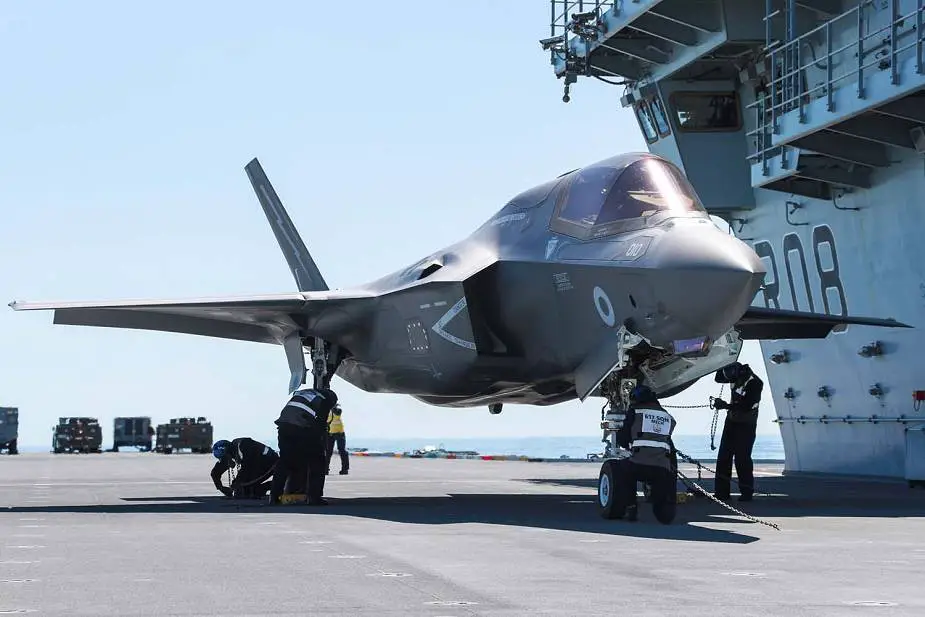The British Navy has announced on June 9, 2020, that Lockheed Martin F-35B Lightning stealth fighter aircraft from the British Royal Air Force 617 Squadron have conducted first landing on British Navy HMS Queen Elizabeth aircraft carrier.
The British Navy has announced on June 9, 2020, that Lockheed Martin F-35B Lightning stealth fighter aircraft from the British Royal Air Force 617 Squadron have conducted first landing on British Navy HMS Queen Elizabeth aircraft carrier.
Follow Navy Recognition on Google News at this link
 Four operational F-35B Lightning takeoff/vertical landing STOVL stealth fighter aircraft landing on HMS Queen Elizabeth British Navy aircraft carrier. (Picture source British Navy)
Four operational F-35B Lightning takeoff/vertical landing STOVL stealth fighter aircraft landing on HMS Queen Elizabeth British Navy aircraft carrier. (Picture source British Navy)
The 617 squadron was reformed on 18 April 2018, and was equipped at RAF Marham in June 2018 with the Lockheed Martin F-35B Lightning, becoming the first squadron to be based in the UK with this advanced V/STOL type.
Pilots, engineers, cyberspace and mission support staff from 617 Squadron, the UK’s operational strike squadron, embarked the carrier over the weekend during a quick stop in Portsmouth for supplies before the aircraft themselves landed on board this afternoon.
The F-35 jets that landed on board today will be the same aircraft that will sail next year with the ship for her maiden Global Carrier Strike Group 21 deployment. HMS Queen Elizabeth will now enter an intense period of flying having just successfully completed four weeks of basic sea training.
The aim is to demonstrate that the jets can successfully defend the aircraft carrier by delivering combat air patrols – launching from the ship to conduct strike missions against a target – and being ready to take off at short notice. After the initial qualification period, 617 Squadron will test their ability to work with Portsmouth-based HMS Queen Elizabeth and Merlin helicopters of Culdrose-based 820 Naval Air Squadron by conducting a number of complex training missions.
This is all in preparation for their second embarkation later in the year when the squadron will join the carrier and her task group for a large multinational training exercise with US, European and NATO partners.
The Royal Navy is transforming into a force centered around carrier strike – supporting the ships as they conduct carrier strike missions, enforce no-fly zones, deploy Royal Marine Commandos, deliver humanitarian aid, and build international partnerships with our allies.

F-35B Lightning takeoff/vertical landing STOVL stealth fighter aircraft on the deck of the British Navy aircraft carrier HMS Queen Elizabeth. (Picture Source British Navy)
The F-35B short takeoff/vertical landing (STOVL) variant is the world’s first supersonic STOVL stealth aircraft. It is designed to operate from austere bases and a range of air-capable ships near front-line combat zones. It can also take off and land conventionally from longer runways on major bases.
The internal weapons bay of the F-35B is reconfigurable for all air-to-ground ordnance, all air-to-air ordnance or a blend of both. A missionized version of the 25 mm GAU-22A cannon is installed or removed as needed.
When stealth is not required to execute a mission, the F-35B external pylons are loaded with ordnance, giving the aircraft a weapons payload of more than 15,000 pounds.
The HMS Queen Elizabeth is the lead ship of the Queen Elizabeth class of aircraft carriers, the largest warships ever built for the British Navy of the United Kingdom. The ship began sea trials in June 2017,[18] was commissioned on 7 December 2017 and is scheduled to enter service in 2020.
The HMS Queen Elizabeth is able to carry forty aircraft, a maximum of thirty-six F-35s and four helicopters. The 2010 SDSR anticipated the routine peacetime deployment of twelve F-35Bs, but a typical combat load will be 24 F-35Bs and some helicopters. These could be a Maritime Force Protection package of nine anti-submarine Merlin HM2 and five Merlin Crowsnest for airborne early warning; alternatively, a Littoral Manoeuvre package could include a mix of Royal Navy Commando Helicopter Force Merlin HC4, Wildcat AH1, RAF Chinooks, and Army Air Corps Apaches.







